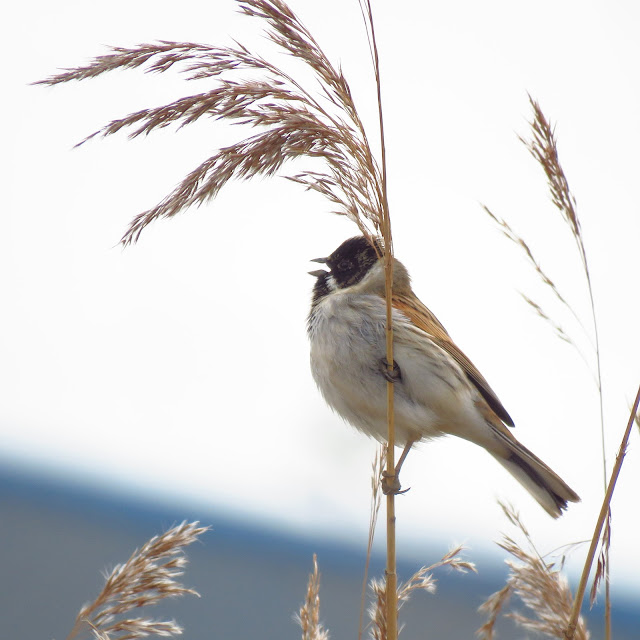Reed Buntings are sparrow-sized birds, with proportionally longer tails and thinner bills. Males have a black head with a white moustache and collar, and silvery underparts with lightly streaked sides; females are browner with a streaky head. Territorial males will sing their not very musical, slow and chirpy song standing quite upright, from a prominent perch such as atop a reed seed head or bush.
Female Reed Bunting at Oak Road Lake, 10/03/2021. Top shot, male singing by Oak Road Playing fields on the same day.
Reed Buntings breed in reed beds, wetlands, river banks and farmland, particularly favouring rapeseed fields. They seem to have a requirement for wet soils, rather than the vegetation itself or the presence of water. They feed on seeds and during the breeding season will take many invertebrates, with which they feed their chicks. In winter, they join flocks of other buntings and finches and can be more widespread. They may also visit gardens then in search of food.
Male Reed Bunting at Noddle Hill LNR,
In Hull, Reed Buntings are scarce but regular birds, which are limited by habitat availability. They can be found more easily in the outskirts of the city (Noddle Hill, Bransholme, Willerby Carrs) and on the banks of the River Hull north of Clough Road, including at Oak Road Lake and Bransholme reservoir, and also in the silted-up basin of St Andrews Quay and eastern docks.
Conservation
The Reed Bunting is protected in the UK by the Wildlife and Countryside act (1981) and is an Amber listed species. The species suffered strong population declines before the turn of the millennium, and it was Red listed in the UK. After some recovery in populations, it was moved to the Amber list in 2015. Some evidence pointed to reduced winter survival due to food scarcity as the main driver to the population declines. The Reed Bunting has its own UK Biodiversity Action Plan and has a
Biodiversity Action plan in Hull. Efforts to protect and increase the number of wetlands and reed beds may have favoured the species in the UK. There is potential to drive a positive change to Reed Buntings and other wetland species by management of urban wetlands and linear waterways in Hull. Reed Buntings may benefit from reducing the mowing regime of river flood banks, ditches, and drains in a 2 or 3 year rotation, to maintain nesting habitat and longer grassland in the banks. Buffer strips of tall grassy margins could be allowed to set seed around playing fields, ponds, and the recently developed aqua-greens will help feed them through the winter and will support invertebrates in the summer. Population monitoring to quantify the effect of these changes would also be desirable.

Male Reed Bunting. Noddle Hill LNR.
More information
BTO Bird Facts.
Reed Bunting.





No comments:
Post a Comment